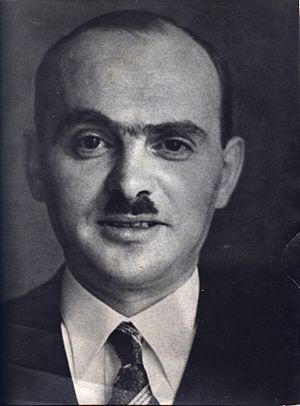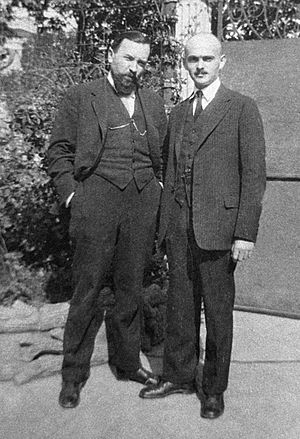Leon Gaikis facts for kids
Quick facts for kids
Leon Gaikis
|
|
|---|---|
| Леонид Яковлевич Гайкис | |
 |
|
| Born | 1898 Warsaw, Congress Poland, Russian Empire
|
| Died | 21 August 1937 (aged 38–39) |
| Citizenship | Russian, Soviet |
| Occupation | Diplomat |
| Title | Soviet ambassador to Spain |
| Term | 1937 |
| Predecessor | Marcel Rosenberg |
| Successor | Sergey Aleksandrovich Bogomolov (1977) |
| Political party | Communist Party of the Soviet Union |
| Spouse(s) | Helena Gaikis |
Leonid Yakovlevich Gaikis (born in 1898 in Warsaw – died on August 21, 1937, in Moscow) was a Soviet diplomat. He became the second Soviet ambassador to Spain during the Spanish Civil War. In 1937, he was called back to Moscow. There, he was arrested and executed as part of a difficult period known as the Great Purge.
Contents
Early Life and Education
Leonid Gaikis was born in 1898 in Warsaw. At that time, Warsaw was part of the Russian Empire. His family was Jewish. His original name was Leon Haykis. Later, his name became Gaikis or Khaikis. His childhood was shaped by big events in society. One of these was the Polish Revolution of 1905.
He studied philosophy at the University of Warsaw. However, he did not finish his studies there. Before 1914, he supported the 'Polish Socialist Party – Left'. From 1914 to 1915, he worked as a teacher. This was during World War I, when Poland was occupied by powerful nations.
In 1917, the year of the Russian Revolution, he joined a political party. This party was called 'Social Democracy of the Kingdom of Poland and Lithuania'. The next year, this party joined with another to form the Communist Workers' Party of Poland. In 1918, Gaikis was arrested in Warsaw. This was because he was spreading communist ideas. His party did not support the new Second Polish Republic. Instead, they supported the Bolsheviks during the Polish–Soviet War.
Joining the Red Army
In 1919, when he was 21, Gaikis joined the Red Army. He served in the Russian Civil War. After 1919, he became an officer. He worked for the Kazakh Military Revolutionary Committee. From February 1920, he helped organize local groups. He also worked on a special team. This team surveyed and organized local councils. In late 1920, he managed business and was a secretary for the Kazakh committee.
Soviet Diplomatic Career
Starting in Diplomacy
In 1921, Gaikis started working for the People's Commissariat of Foreign Affairs. This was like the foreign ministry. He was a secretary for a group dealing with borders. From 1922 to 1923, he worked in the main office of this ministry. Then, from 1923 to 1924, he was a secretary. He worked for Georgy Chicherin, who was in charge of foreign affairs.
Time in Mexico
From 1924 to 1928, Gaikis was the first secretary at the Soviet embassy in Mexico. He started when Stanislav Pestkovsky was the first Soviet ambassador. Pestkovsky later died during Stalin's Great Purge in 1937.
In 1925, Gaikis met the famous poet Vladimir Mayakovsky in Mexico. He helped Mayakovsky get a visa to visit the United States.
From 1926 to 1927, Alexandra Kollontai was the ambassador. During this time, Gaikis was in charge of trade. In 1927, Kollontai wrote in her diary. She mentioned how few staff they had. She said they were very isolated. They even had to send important letters by regular mail.
Later Diplomatic Roles
From 1929 to 1933, Gaikis worked for the Profintern system. This was an international workers' organization. From 1933 to 1935, he returned to the main office of the Soviet foreign ministry. Then, from 1935 to 1936, he served as the Consul General in Istanbul, a major city in Turkey.
Spain and the Great Purge
The Soviet Union started official relations with the Second Spanish Republic in 1933. Anatoly Lunacharsky was supposed to be the ambassador to Spain. But he sadly died on his way there. Eventually, Marcel Rosenberg became the first ambassador in 1936. Leon Gaikis went with him as an adviser. They arrived in Madrid on August 27, 1936. This was after the Spanish Civil War had already begun.
The next year, Rosenberg was called back to Moscow. This happened after a meeting between Stalin and the Spanish ambassador. Stalin said he wanted someone "less enfant terrible" for the job. On February 19, 1937, Gaikis was chosen to replace Rosenberg. Rosenberg soon disappeared during the Great Purge.
Gaikis himself soon faced similar problems. In June 1937, he was called back to Moscow. He thought it was a normal trip. But he was arrested on June 16, right after he arrived. The next day, he was removed from his job. He was accused of supporting a group that wanted more party democracy in 1923. This group was linked to Leon Trotsky. So, Gaikis was accused of "Trotskyism."
His name appeared on one of Stalin's execution lists. This list was dated August 20, 1937. It ordered his execution. The Military College of the Supreme Court of the Soviet Union confirmed the order. He was sentenced to death. This was for "betrayal of the Fatherland" and being part of a "counter-revolutionary terrorist organization." He was executed on the same day, August 21, 1937. He was 39 years old. His body was cremated in Moscow.
After Rosenberg and Gaikis, no new official ambassador was appointed. The embassy was led by a temporary diplomat. This continued until 1939. That year, Francisco Franco's forces won the Spanish Civil War. All diplomatic relations were then broken. It was not until 1977, after Franco's death, that relations were restored. A new ambassador was then appointed.
Leon's wife, Helena, stayed in Spain with their two young daughters. She later went to Russia to find out what happened. She was immediately removed from the Communist Party of the Soviet Union. In 1941, she was arrested. This was under a law that held family members responsible for accused people. She was sentenced to 10 years and sent to Siberia. In 1945, at the end of World War II, she was released. She was sent to the damaged city of Warsaw.
After Stalin died, the Soviet Union began a process called de-Stalinization. As part of this, Leon Gaikis was officially cleared of all charges. This happened on December 17, 1955.
See Also
 In Spanish: Leon Gaykis para niños
In Spanish: Leon Gaykis para niños
- Foreign relations of the Soviet Union
Images for kids






